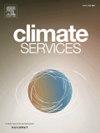基于流域的反映水循环特征的环境干旱指数的开发与应用
IF 4.5
3区 环境科学与生态学
Q2 ENVIRONMENTAL SCIENCES
引用次数: 0
摘要
气候变化导致的干旱通过恶化水质日益影响水生生态系统。然而,传统的干旱指数主要关注水量,限制了它们捕捉环境影响的能力。为了解决这一差距,本研究在Srivastava和Maity(2023)最初提出的环境干旱指数(EDI)的基础上开发了水质环境干旱指数(WQEDI),后来由Jo等人(2024)进行了修改,以包括水质指标。WQEDI引入了三个关键创新,包括将水质指标与水文和气象变量相结合;数据驱动的变量选择和加权使用随机森林(RF),并通过决策树(DT)模型的阈值推导;并根据城市、农村和森林流域类型进行流域干旱分级,从而增强空间适应性。验证结果证实,WQEDI在解释力方面优于Jo et al.(2024)提出的EDI,与生化需氧量(BOD)浓度的相关性更强,超出模式更一致。此外,BOD超标率随着WQEDI干旱等级的升高而系统地增加,表明其在捕获环境干旱严重程度方面的有效性。基于这些发现,该研究确定了流域特定的优先等级和干预期,并提出了定制的干旱管理策略。WQEDI为诊断和管理干旱引起的水质恶化提供了一个完善和适应性强的框架。它为环境干旱响应提供了科学依据,并支持以证据为基础的水资源管理和气候适应政策的制定。本文章由计算机程序翻译,如有差异,请以英文原文为准。
Development and application of a watershed-based environmental drought index reflecting water cycle characteristics
Droughts driven by climate change increasingly affect aquatic ecosystems by deteriorating water quality. However, conventional drought indices primarily focus on water quantity, limiting their ability to capture environmental impacts. To address this gap, this study develops the Water Quality Environmental Drought Index (WQEDI), building on the Environmental Drought Index (EDI) originally proposed by Srivastava and Maity (2023) and later adapted by Jo et al. (2024) to include water quality indicators.
WQEDI introduces three key innovations, including the integration of water quality indicators alongside hydrological and meteorological variables; data driven variable selection and weighting using Random Forest (RF), with threshold derivation via Decision Tree (DT) models; and watershed- specific drought grading tailored to urban, rural, and forest watershed typologies, thereby enhancing spatial adaptability.
Validation results confirmed that WQEDI outperforms the EDI proposed by Jo et al. (2024) in terms of explanatory power, showing stronger correlations with biochemical oxygen demand (BOD) concentrations and more consistent exceedance patterns. Moreover, BOD exceedance rates systematically increased with higher WQEDI drought grades, demonstrating its effectiveness in capturing environmental drought severity.
Based on these findings, the study identified watershed-specific priority grades and intervention periods and proposed customized drought management strategies. WQEDI provides a refined and adaptable framework for diagnosing and managing drought induced water quality deterioration. It offers a scientifically grounded basis for environmental drought response and supports the development of evidence-based water management and climate adaptation policies.
求助全文
通过发布文献求助,成功后即可免费获取论文全文。
去求助
来源期刊

Climate Services
Multiple-
CiteScore
5.30
自引率
15.60%
发文量
62
期刊介绍:
The journal Climate Services publishes research with a focus on science-based and user-specific climate information underpinning climate services, ultimately to assist society to adapt to climate change. Climate Services brings science and practice closer together. The journal addresses both researchers in the field of climate service research, and stakeholders and practitioners interested in or already applying climate services. It serves as a means of communication, dialogue and exchange between researchers and stakeholders. Climate services pioneers novel research areas that directly refer to how climate information can be applied in methodologies and tools for adaptation to climate change. It publishes best practice examples, case studies as well as theories, methods and data analysis with a clear connection to climate services. The focus of the published work is often multi-disciplinary, case-specific, tailored to specific sectors and strongly application-oriented. To offer a suitable outlet for such studies, Climate Services journal introduced a new section in the research article type. The research article contains a classical scientific part as well as a section with easily understandable practical implications for policy makers and practitioners. The journal''s focus is on the use and usability of climate information for adaptation purposes underpinning climate services.
 求助内容:
求助内容: 应助结果提醒方式:
应助结果提醒方式:


